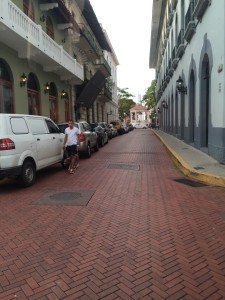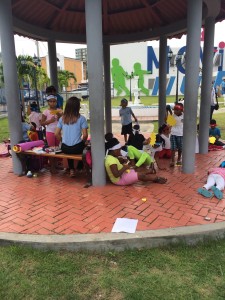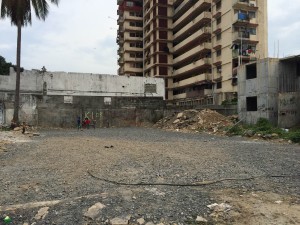City of Contrast
Traveling tens of thousands of feet above the Earth’s surface on my way to Panama, I did not know what to expect to see upon my arrival in Panama. My knowledge of Panama was constricted to America’s critical involvement in building one of the world’s largest man-made endeavors known as the Panama Canal. This was my first trip to Latin America excluding the one time I took a Carnival Cruise to Cozumel, Mexico, but that can be overlooked! Since Panama stands as the crossroad between the East and West, it has a unique culture brought by a fusion of Panamanians and internationals.
 As soon as I arrived, a local described Panama City as a “city of contrast.” Panama is an upper middle-income country. Due to the Canal, it has attracted many international investors that have brought much wealth to the country. This wealth is reflected in the large, urban strip of skyscrapers that stretches along the water. The deluge of new money has provided the city with fancy restaurants, casinos, and other luxuries. Right across the Bay of Panama, there is the older, historical part of the city called Cosco Viejo. Filled with French-inspired architecture, the narrow streets and many balconies of the buildings would make you think that you have been transported to a small French town. However, next to all of this European charm, lies an area that is burdened by intense poverty--a poverty that can only be described as a family of nine living in cramped conditions surrounded by trash everywhere. Police patrol the dirt roads due to the mounting fear and violence of gangs. This Panama City is the complete opposite of its surroundings. The juxtaposition between the old and new along with the rich and poor is so conspicuous and so sharp that it is startling.
As soon as I arrived, a local described Panama City as a “city of contrast.” Panama is an upper middle-income country. Due to the Canal, it has attracted many international investors that have brought much wealth to the country. This wealth is reflected in the large, urban strip of skyscrapers that stretches along the water. The deluge of new money has provided the city with fancy restaurants, casinos, and other luxuries. Right across the Bay of Panama, there is the older, historical part of the city called Cosco Viejo. Filled with French-inspired architecture, the narrow streets and many balconies of the buildings would make you think that you have been transported to a small French town. However, next to all of this European charm, lies an area that is burdened by intense poverty--a poverty that can only be described as a family of nine living in cramped conditions surrounded by trash everywhere. Police patrol the dirt roads due to the mounting fear and violence of gangs. This Panama City is the complete opposite of its surroundings. The juxtaposition between the old and new along with the rich and poor is so conspicuous and so sharp that it is startling.
 My five day visit to Panama was sponsored by UNICEF, the world-renowned organization to fight for children’s rights. The UNICEF country office has pledged to improve the lives of children by focusing on youth education as well as child protection. This applies to the especially poor region of Panama City. The kids who live there are at the greatest risk of falling into pernicious activities such as joining gangs and of not prioritizing their schoolwork and education. UNICEF has pledged to support organizations such as Movimiento Nueva Generacion that provides after school activities in a safe haven away from the dangerous street full of gangs and drugs. Of the many visits I made to Panamanian organizations, I spent several hours there interacting with the kids. Despite having a language barrier, when I smiled and waved at them, they reciprocated with laughter and smiles. The gratification that I gained from having the kids smile back taught me that giving back can come in multiple forms. I learned that a smile is such a universal way of communicating. Just spending a few hours there, I could tell there is so much passion being fostered by this great institution.
My five day visit to Panama was sponsored by UNICEF, the world-renowned organization to fight for children’s rights. The UNICEF country office has pledged to improve the lives of children by focusing on youth education as well as child protection. This applies to the especially poor region of Panama City. The kids who live there are at the greatest risk of falling into pernicious activities such as joining gangs and of not prioritizing their schoolwork and education. UNICEF has pledged to support organizations such as Movimiento Nueva Generacion that provides after school activities in a safe haven away from the dangerous street full of gangs and drugs. Of the many visits I made to Panamanian organizations, I spent several hours there interacting with the kids. Despite having a language barrier, when I smiled and waved at them, they reciprocated with laughter and smiles. The gratification that I gained from having the kids smile back taught me that giving back can come in multiple forms. I learned that a smile is such a universal way of communicating. Just spending a few hours there, I could tell there is so much passion being fostered by this great institution.
 Seeing such potential through observing these kids gave me hope that there will be a new wave of youths who want to genuinely change Panama for the better. This new generation will be better educated and more prepared through properly allocated resources that will give them the skillsets to be the future that they want to see. Panama City should instead be known as a city of hope.
Seeing such potential through observing these kids gave me hope that there will be a new wave of youths who want to genuinely change Panama for the better. This new generation will be better educated and more prepared through properly allocated resources that will give them the skillsets to be the future that they want to see. Panama City should instead be known as a city of hope.
All pictures courtesy of Jackie Landry.
